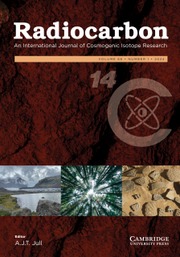Article contents
University of Texas at Austin Radiocarbon Dates XIV
Published online by Cambridge University Press: 18 July 2016
Extract
This list reports certain 14C measurements completed by December 1979; other projects completed by this time will be reported later. Age calculations are based on 14C half-life of 5568 yr and modern standard of 95% NBS oxalic acid, supplemented by tree rings of pre-industrial wood from a log cut in the 1850's (Tx-540; R, 1970, v 12, p 249). Deviations reported are based on counting statistics of sample, background and modern, and are ± 1σ, except that when sample count approaches either modern or background, 2σ limits are reported. Unless noted, 12C/13C measurements were not made and results are not corrected for 13C fractionation (assumed ratio = −25‰ WRT PDB). Our laboratory uses liquid scintillation counting of benzene, with Li2C2 and vanadium-activated catalyst in preparation; chemical yields range between 95% and 99%. Three counters are employed; a Packard Tri-Carb Model 3002 and 2 Beckman LS230 spectrometers obtained through a grant from the National Science Foundation.
Information
- Type
- Date Lists
- Information
- Copyright
- Copyright © The American Journal of Science
References
- 5
- Cited by

